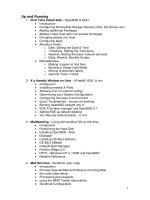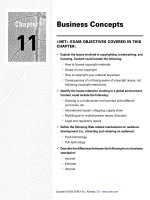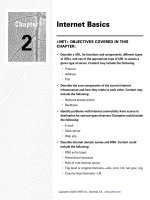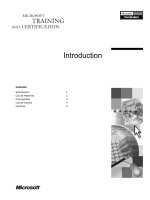Tài liệu AppleTalk Basics pdf
Bạn đang xem bản rút gọn của tài liệu. Xem và tải ngay bản đầy đủ của tài liệu tại đây (33.3 KB, 7 trang )
1-7 Semester 8 Internetwork Troubleshooting v1.0 - Lab 11.2.1 Copyright 2001, Cisco Systems, Inc.
Lab 11.2.1: AppleTalk Basics
SanJose1 SanJose2
DCE 400.2 s0/0
s0/0 400.1
e0/0 500.1
Cable Range
400-400
Zone: WanLink
e0/0 300.1
Cable Range
500-599
Zone: SanJose2
Cable Range
300-399
Zone: SanJose1
Objective
This lab will cover the basics of configuring an AppleTalk network and the most
common troubleshooting commands. This lab covers:
• AppleTalk router configuration using RTMP
• Show commands
• Debug AppleTalk routing
Warning: The debug command, because of its heavy use of CPU cycles, can
be devastating to a production router’s performance. It is possible that a debug
command running during a moderate to heavy traffic period could literally
consume all CPU cycles and effectively stop routing, resulting in discarded
frames. This discussion is included primarily as a tool to help you visualize how
and why certain network processes occur. We will also look at options that can
reduce the impact of the debug commands.
Scenario
International Travel Agency (ITA) is considering adding AppleTalk to a couple
LANs and a WAN link for the graphic art employees. Before they do, they have
asked you to build a small prototype so that they can better understand what is
involved and so that they can run some tests on traffic patterns.
If the lab is done in pairs, each person can run the lab steps albeit each host
may display slightly different results. It might be beneficial to coordinate your
efforts and compare results.
Step 1
This lab can be done on any router that uses a version of the IOS that supports
AppleTalk. Each router requires a serial interface and any type of LAN
interface.
2-7 Semester 8 Internetwork Troubleshooting v1.0 - Lab 11.2.1 Copyright 2001, Cisco Systems, Inc.
Cable the lab as shown in the diagram.
Step 2
Configure SanJose1 using the following information. The Appletalk specific
commands are highlighted and the information in parentheses is explanation
but not intended to be configured:
hostname SanJose1
!
enable secret cisco
!
appletalk routing (enables AppleTalk routing on the device)
!
interface Fastethernet0/0 (or whatever the LAN interface is)
no ip address
no keepalive (you don’t need a switch although its nice)
appletalk cable-range 300-399 300.1 (defines cable range & address for interface)
appletalk zone SanJose1 (defines primary Zone for interface)
no shutdown
!
interface Serial0/0 (or whatever the LAN interface is)
no ip address
encapsulation ppp
appletalk cable-range 400-400 400.1 (defines cable range & address for interface)
appletalk zone WanLink (defines primary Zone for interface)
clockrate 64000
no shutdown
!
no ip classless
no ip http server
!
line con 0
password cisco
logging synchronous
login
transport input none
line aux 0
password cisco
login
line vty 0 4
password cisco
login
!
Be sure to save your configuration. Occasionally you need to reboot the router
if you change the configuration.
Step 3
Configure SanJose2 using the following information. The Appletalk specific
commands are highlighted and the information in parentheses is explanation
but not intended to be configured:
hostname SanJose2
!
enable secret cisco
!
appletalk routing (enables AppleTalk routing on the device)
!
interface Fastethernet0/0 (or whatever the LAN interface is)
no ip address
no keepalive (you don’t need a switch although its nice)
appletalk cable-range 500-599 500.1 (defines cable range & address for interface)
appletalk zone SanJose2 (defines primary Zone for interface)
3-7 Semester 8 Internetwork Troubleshooting v1.0 - Lab 11.2.1 Copyright 2001, Cisco Systems, Inc.
no shutdown
!
interface Serial0/0 (or whatever the LAN interface is)
no ip address
encapsulation ppp
appletalk cable-range 400-400 400.2 (defines cable range & address for interface)
appletalk zone WanLink (defines primary Zone for interface)
no shutdown
!
no ip classless
no ip http server
!
line con 0
password cisco
logging synchronous
login
transport input none
line aux 0
password cisco
login
line vty 0 4
password cisco
login
!
Be sure to save your configuration. Occasionally you need to reboot the router
if you change the configuration.
Step 4
The show appletalk route command.
Type the show appletalk route command to display the AppleTalk route
table. It may take several minutes for the routes to all show. If the zones are
unnamed it’s a good sign that you haven’t waited long enough. AppleTalk
updates every 10 seconds so it shouldn’t take long. Notice that the route from
the other LAN is learned by RTMP which is AppleTalk’s flavor of RIP.
SanJose1#show appletalk route
Codes: R - RTMP derived, E - EIGRP derived, C - connected, A - AURP
S - static P - proxy
3 routes in internet
The first zone listed for each entry is its default (primary) zone.
C Net 300-399 directly connected, Ethernet0, zone SanJose1
C Net 400-400 directly connected, Serial0, zone WanLink
R Net 500-599 [1/G] via 400.2, 2 sec, Serial0, zone SanJose2
SanJose1#
A cable range is the range of network numbers that exist on a network
segment. Hosts can select their own address from within the cable range, after
performing a broadcast announcing its intention. If no other host is using that
address then the host can use it. The value the host picks is usually a decimal
value so even a cable range of 40-42 could have many host addresses like
40.167 and 41.2145. You kept the cable range for the WAN link small because
there were only going to be two connections – similar to using a small subnet.
4-7 Semester 8 Internetwork Troubleshooting v1.0 - Lab 11.2.1 Copyright 2001, Cisco Systems, Inc.
Step 5
The show appletalk zone command.
Type the show appletalk zone command to display the AppleTalk
equivalent of a VLAN or workgroup. A zone is a way of grouping resources so
that the user can readily pick local printers and other shared resources. Notice
that the command associates the zone name with one or more cable ranges.
SanJose1#show appletalk zone
Name Network(s)
WanLink 400-400
SanJose1 300-399
SanJose2 500-599
Total of 3 zones
SanJose1#
Step 6
The show appletalk globals command.
Type the show appletalk globals command to display a summary of the
AppleTalk network and related features. The command summarizes the
number of routes and zones (highlighted) as well as displaying the protocol
settings for routing updates. You should see that AppleTalk is both chatty
(every 10 seconds) and unforgiving (routes are considered BAD after 20
seconds or only two missed routing cycles).
SanJose1#show appletalk globals
AppleTalk global information:
Internet is incompatible with older, AT Phase1, routers.
There are 3 routes in the internet.
There are 3 zones defined.
Logging of significant AppleTalk events is disabled.
ZIP resends queries every 10 seconds.
RTMP updates are sent every 10 seconds.
RTMP entries are considered BAD after 20 seconds.
RTMP entries are discarded after 60 seconds.
AARP probe retransmit count: 10, interval: 200 msec.
AARP request retransmit count: 5, interval: 1000 msec.
DDP datagrams will be checksummed.
RTMP datagrams will be strictly checked.
RTMP routes may not be propagated without zones.
Routes will not be distributed between routing protocols.
Routing between local devices on an interface will not be performed.
IPTalk uses the udp base port of 768 (Default).
AppleTalk EIGRP is not enabled.
Alternate node address format will not be displayed.
Access control of any networks of a zone hides the zone.
SanJose1#
Step 7
The show appletalk traffic command.
Type the show appletalk traffic command to display a summary of all
AppleTalk traffic sent and received by the device.
SanJose1#show appletalk traffic
AppleTalk statistics:
Rcvd: 32 total, 0 checksum errors, 0 bad hop count
32 local destination, 0 access denied, 0 fast access denied
0 for MacIP, 0 bad MacIP, 0 no client
5-7 Semester 8 Internetwork Troubleshooting v1.0 - Lab 11.2.1 Copyright 2001, Cisco Systems, Inc.
6 port disabled, 0 no listener
0 ignored, 0 martians
Bcast: 0 received, 61 sent
Sent: 63 generated, 0 forwarded, 0 fast forwarded, 0 loopback
0 forwarded from MacIP, 0 MacIP failures
0 encapsulation failed, 0 no route, 0 no source
DDP: 32 long, 0 short, 0 macip, 0 bad size
NBP: 15 received, 0 invalid, 0 proxies
0 replies sent, 20 forwards, 15 lookups, 0 failures
RTMP: 20 received, 0 requests, 0 invalid, 0 ignored
41 sent, 0 replies
ATP: 0 received
ZIP: 7 received, 12 sent, 0 netinfo
Echo: 0 received, 0 discarded, 0 illegal
0 generated, 0 replies sent
Responder: 0 received, 0 illegal, 0 unknown
0 replies sent, 0 failures
AARP: 0 requests, 0 replies, 0 probes
0 martians, 0 bad encapsulation, 0 unknown
AppleTalk statistics:
10 sent, 0 failures, 0 delays, 0 drops
Lost: 0 no buffers
Unknown: 0 packets
Discarded: 0 wrong encapsulation, 0 bad SNAP discriminator
AURP: 0 Open Requests, 0 Router Downs
0 Routing Information sent, 0 Routing Information received
0 Zone Information sent, 0 Zone Information received
0 Get Zone Nets sent, 0 Get Zone Nets received
0 Get Domain Zone List sent, 0 Get Domain Zone List received
0 bad sequence
SanJose1#
Step 8
The show appletalk interface command.
Type the show appletalk interface command to display the
configuration information relative to the interfaces. As with its IP cousin an
interface designation (show appletalk interface serial 0/0) could be
added to the command to limit the output to one interface.
SanJose1#show appletalk interface
Ethernet0 is up, line protocol is up
AppleTalk cable range is 300-399
AppleTalk address is 300.1, Valid
AppleTalk zone is "SanJose1"
AppleTalk address gleaning is disabled
AppleTalk route cache is enabled
Serial0 is up, line protocol is up
AppleTalk cable range is 400-400
AppleTalk address is 400.1, Valid
AppleTalk zone is "WanLink"
AppleTalk port configuration verified by 400.2
AppleTalk address gleaning is not supported by hardware
AppleTalk route cache is enabled
Serial1 is administratively down, line protocol is down
AppleTalk protocol processing disabled
SanJose1#
Step 9
The show appletalk neighbors command.
Type the show appletalk neighbors command to display the neighbor(s)
immediately adjacent to the local device. The command includes the neighbor’s
address and the local interface that will reach that neighbor.
6-7 Semester 8 Internetwork Troubleshooting v1.0 - Lab 11.2.1 Copyright 2001, Cisco Systems, Inc.
SanJose1#show appletalk neighbors
AppleTalk neighbors:
400.2 Serial0, uptime 00:05:13, 3 secs
Neighbor has restarted 1 time in 00:06:13.
Neighbor is reachable as a RTMP peer
SanJose1#
Step 10
The ping appletalk command.
Type the ping appletalk network-id command to access Cisco’s
AppleTalk version of the TCP/IP connectivity tool ping. Ping the LAN interface
on the other router (500.1 for SanJose2 or 300.1 for SanJose1).
SanJose1#ping appletalk 500.1
Type escape sequence to abort.
Sending 5, 100-byte AppleTalk Echos to 500.1, timeout is 2 seconds:
!!!!!
Success rate is 100 percent (5/5), round-trip min/avg/max = 36/36/40 ms
SanJose1#
Typing trace appletalk network-id reveals that you are just a little too
fast for Cisco. There is no AppleTalk version of Trace (yet).
SanJose1#trace appletalk 500.1
%Not yet implemented.
SanJose1#
Step 11
The show appletalk arp command.
Type the show appletalk arp command to display the AppleTalk ARP
table. You should notice that like it’s IP cousin only the LAN interfaces and
hosts are included.
SanJose1#show appletalk arp
Address Age (min) Type Hardware Addr Encap Interface
300.1 - Hardware 0010.7b3a.3f60.0000 SNAP Ethernet0
SanJose1#
Step 12
The debug apple routing command.
Type the debug apple routing command to begin debug for both RTMP
and EIGRP routing. Using the debug apple ? command would have
revealed that there are options for debugging just RTMP or various views of
EIGRP (like in IP).
Notice the time interval between updates from each source.
SanJose1#debug apple routing
AppleTalk RTMP routing debugging is on
AppleTalk EIGRP routing debugging is on
SanJose1#
00:13:05: AT: src=Ethernet0:300.1, dst=300-399, size=22, 2 rtes, RTMP pkt sent
00:13:05: AT: src=Serial0:400.1, dst=400-400, size=16, 1 rte, RTMP pkt sent
00:13:05: AT: Route ager starting on Main AT RoutingTable (3 active nodes)
00:13:05: AT: Route ager finished on Main AT RoutingTable (3 active nodes)
SanJose1#
7-7 Semester 8 Internetwork Troubleshooting v1.0 - Lab 11.2.1 Copyright 2001, Cisco Systems, Inc.
00:13:10: AT: RTMP from 400.2 (new 0,old 1,bad 0,ign 0, dwn 0)
SanJose1#
00:13:15: AT: src=Ethernet0:300.1, dst=300-399, size=22, 2 rtes, RTMP pkt sent
00:13:15: AT: src=Serial0:400.1, dst=400-400, size=16, 1 rte, RTMP pkt sent
00:13:15: AT: Route ager starting on Main AT RoutingTable (3 active nodes)
00:13:15: AT: Route ager finished on Main AT RoutingTable (3 active nodes)
SanJose1#
00:13:20: AT: RTMP from 400.2 (new 0,old 1,bad 0,ign 0, dwn 0)
SanJose1#
00:13:25: AT: src=Ethernet0:300.1, dst=300-399, size=22, 2 rtes, RTMP pkt sent
00:13:25: AT: src=Serial0:400.1, dst=400-400, size=16, 1 rte, RTMP pkt sent
00:13:25: AT: Route ager starting on Main AT RoutingTable (3 active nodes)
00:13:25: AT: Route ager finished on Main AT RoutingTable (3 active nodes)
SanJose1#un all
All possible debugging has been turned off
Step 13
Save your work because the next lab uses this configuration as a starting point.
Reflection
Given what you have seen. What are the implications for adding AppleTalk to
an existing IP network?
Does the WAN link make any difference?
Why not just configure AppleTalk on the entire network and allow employees to
choose the platform they prefer?









